German Shepherd Great Dane Mix: The Best Big Dog For A Family?
What if you combined the biggest known lapdog with the most versatile canine worker? What two breeds would even come to mind?
Although classified by the American Kennel Club and FIC as a working dog, the Great Dane now mainly serves as a companion.
More recently, Great Danes have been used as physical assistance dogs, as well as in search and rescue ventures. However, she would be in heaven sitting on your lap.
In comparison, German Shepherds are quite different. GSDs are known to be focused, driven, and seemingly able to do almost anything from police apprehension and agility, to therapy and scaling walls.
A German Shepherd Great Dane mix is a large designer dog that combines a sweet and friendly demeanor with a large and protective spirit, and a powerful and formidable physical presence.
Also known as Great Shepherds and Dane Shepherds, many dog owners seek out this mix for their attractive yet unique appearance, size, and suitability as well-rounded family companions.
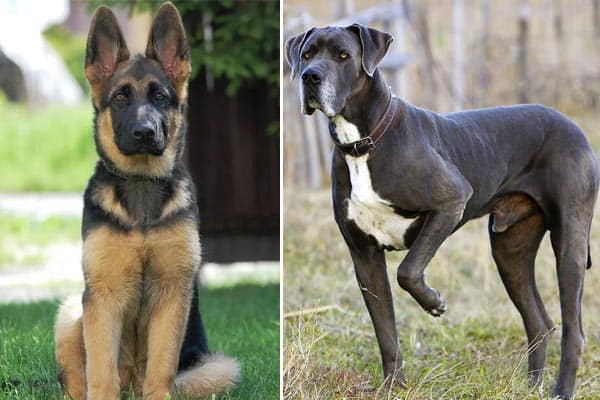
German Shepherd Great Dane Mix: Brief Overview Of Breed Traits
| Height | Weight | Appearance | Coat | Health | Family Friendly? | Temperament | Training & Exercise | Price |
|---|---|---|---|---|---|---|---|---|
| 28 - 30 inches tall at the shoulders | 65 - 130 lbs | Majestic-looking. Among largest crossbreeds on earth - this mix is considered a large to giant-sized breed. Typical colors: black, brown, hazel, white, merle. Brown eyes, black nose, and ears usually long & upright like the GSD. | Great Dane genetics will typically give these dogs a shorter coat that's easier to manage than a GSD's, but this varies depending on parent dogs. Will still shed regularly & seasonally - daily brushing & occasional bathing is recommended. | Lifespan: 8 - 13 years. Hybrid breeds' genetic diversity helps overall health, but this mix is still prone to certain problems: Hip & Elbow Dysplasia, Bloat, allergies, and skin infections. | Yes, they can be great family pets that get along with kids & other pets, but will still need training & socialization. They need to be supervised around young kids due to their large size. | Smart, energetic, loving, warm, affectionate, friendly, loyal, protective. Can be wary around strangers. | Their intelligence and energy makes these dogs trainable, but they'll need a lot of daily exercise - big open spaces are great for these large dogs to run around in. This will help limit any destructive behaviors. | $600 - $1,000. This will depend on the breeder. |
German Shepherds developed from a small pool of herding dogs in Germany in the late 1890s.
Hektor eventually became the founding sire and was first named German Shepherd Dog in 1899 thanks to the keen eye and ambitious goals of Max von Stephanitz.
German Shepherds split from a group of dogs similar in appearance and purpose that included the Dutch Shepherd and the Belgian Shepherd.
The Belgian Shepherds would eventually divide even further. They would include the well-known Belgian Malinois and three other types.
A scientific article that addresses evolution in certain dog breeds states that the five Italian herding dogs, like the Bergamasco Shepherd, had ancestors in common with the German Shepherd.
The German Shepherd line split from the Italian dogs and a French herding dog around 1859.
The Old Great Danes had a few things in common with German Shepherds. First, fanciers developed the breed in Germany in the late 1800s.
Second, the Great Dane’s purpose changed over time as she came closer to her current status as a pet and family companion. Finally, Great Danes evolved in appearance over the passing generations.
Great Danes have much more ancient roots than German Shepherds. They appear in the art of Egypt from 4,000 B.C., Babylon from 2,000 B.C., and China from about 1100 B.C.
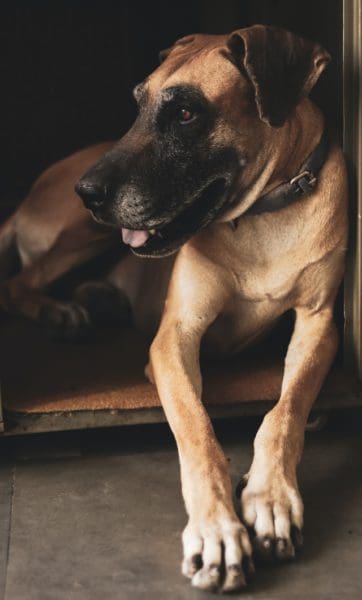
Assyrians owned dogs that resembled Mastiffs thought to have ancestors who were Tibetan Mastiff as well as the English Mastiff, according to Illini Great Dane Club.
As you have probably surmised by now, Great Danes are not Danish, although they had a distinctive slender type in Denmark.
Danes became proficient at hunting wild boars, which at the time, hunters considered among the most challenging game to overpower.
Boars were incredibly strong, smart, quick, and fearless. The dogs who hunted them had to be tough in mind and body and very swift of foot.
Breeders during the 14th century blended their huge Mastiffs with the fast-coursing Greyhound and perhaps the scrappy Irish Wolfhound to produce the ideal boar dog that would come in at the end of the pursuit and grab and hold the hog.
Early Great Danes were heavy-boned dogs, resembling Mastiffs more than Greyhounds or Wolfhounds.
Their slow transformation began in the 1600s when German noblemen discovered the fearless and magnificent Great Dane.
These people of elevated status did not often hunt boars, but they appreciated how large and imposing the Danes were. They began seeking out the dogs for their families and to guard their properties.
Nobility selected dogs for good looks and height because beauty and intimidation were of paramount importance for aristocratic households.
After progressive selection for taller dogs, the breed standard for the Great Dane was born about 1880.
Like some other breeds, the Great Dane’s name varies depending on where you are. In Germany Great Danes still go by the name German Dogge or Deutsche Dogge, Dogge being the word for a mastiff.
How Distinct & Large Will Your German Shepherd Great Dane Mix Be?
You will have a large hybrid dog
German Shepherds are usually 22 to 26 inches tall at the top of the withers and weigh from 60 to 90 pounds. Males are slightly taller and substantially more muscular than females.
Female Great Danes are 28 to 30 inches at the shoulder while males are 30 to 34 inches tall.
The weight difference is also significant between the genders, with females about 100 to 130 pounds and males as much as 200 pounds.
Even current standards prefer dogs to be as tall as possible. The tallest dog ever was a Great Dane, Zeus, who stood 44 inches at the shoulders.
GSD Great Dane mixes are quite tall at 28 to 30 inches at the shoulders. However, this mix can be very lean at 65 pounds or massive like a Great Dane at up to 130 pounds.
Expect a male to be a little taller and substantially heavier than a female.
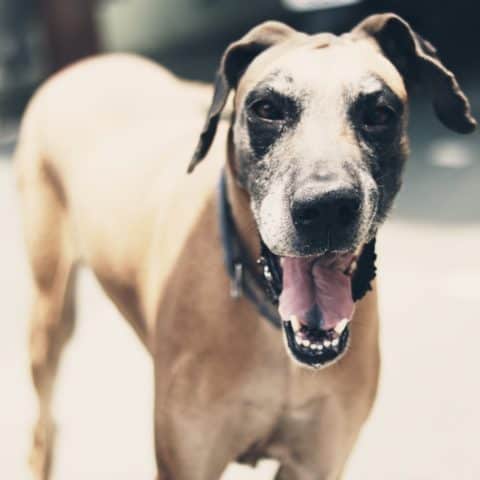
What traits will your Shepherd Dane mix have?
German Shepherds immediately strike you with their confidence and self-assurance.
Most of them are black and mahogany or black and tan.
Even Shepherds who are solid colors like red, blue, or black, are easily recognizable with their noble, slightly domed heads, large erect ears, majestic and powerful necks, rather long torsos, and strong hindquarters built for driving.
A Shepherd’s tail should reach below her hocks, and her gait will be efficient, fluid, and ground-covering. German Shepherds are smaller than Great Danes, but they have as much presence and poise.
The Great Dane is very tall, but your first impression should be one of elegance, strength, and balance.
Like the Shepherd, they have a noble head carriage on a slender but powerful neck. They are galloping dogs in contrast to Shepherds, who are trotting workers.
A Great Dane has a long and deep muzzle with a slightly furrowed brow and medium drop ears.
In North America, owners often crop their dog’s ears. Cropped ears are quite long as they stand upright, especially for show dogs.
Originally, ear cropping had the functional purpose of preventing a dog’s adversaries from shredding his ears on the hunt.
Great Danes notably have long and powerful limbs, relatively square proportions, and a long slender tail that tends to curve up at the tip.
Colors in Great Danes, according to the AKC, can range from fawn to black or black and white. A Great Dane can also be brindle, harlequin, mantle, solid white, blue, or merle.
Unique colors that may not find favor in the show ring are any shades of chocolate including chocolate and white, blue brindle, blue and white, and merlequin.
What are merle, harlequin, and merlequin?
Merle is a marbling effect of the colors grey and black in Great Danes. Color variations of merle, as seen in breeds like the Australian Shepherd, are not standard for Great Danes.
Harlequin, a color pattern unique to Great Danes, is a white base coat with random splotches of black and sometimes gray. Harlequin and merle are closely-related genetically, according to Doggenetics.com.
Merlequin is where the black patches in an otherwise Harlequin dog express as merle splotches.
What about mantle?
Picture a Boston Terrier with a classic black and white coat. In a Great Dane, the Boston black and white color is a mantle, referring to the black blanket effect over an otherwise white dog.
Although some dogs can also be fawn or blue in the areas of black, the traditional tuxedo colors are preferable.
Many Great Dane German Shepherd mixes have a typical look about them. A lot of them have drop ears that face more forward and are smaller than a purebred Great Dane’s ears.
Shepherds mixed with Great Danes commonly sport colors like fawn, merle, black, and black and white.
German Shepherd Great Danes tend to be leggy. Their faces are more triangular and their muzzles narrower than a Great Dane’s.
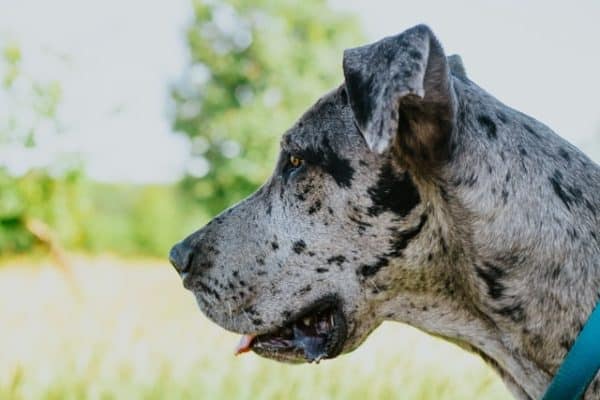
Will Your Great Shepherd Be A Good Guard Dog & Watchdog?
German Shepherds have earned a sometimes justifiable reputation for aggression.
They are naturally protective, a characteristic that people enhanced over the generations to produce good guarding instincts for home security and exceptional bite force for police and military work.
Poor breeding and insufficient or harsh training have led to an unfortunate distortion of some of the Shepherd’s best qualities.
The result of irresponsible breeding has produced a highly popular dog that shows up way higher on biting dogs lists than he should.
German Shepherds are meant to be excellent guard dogs who discriminate appropriately between harmless strangers and malicious intruders.
They should only bite as a last resort or in response to a direct command. Fear aggression with defensive biting persists in some German Shepherd lines.
Great Danes were hunting dogs before they were guard dogs. Today, they are companion animals before they are formidable guards.
Although inheriting some guarding instincts from their Mastiff bloodlines, Great Danes often have a bark worse than their bite. However, Danes always historically could be protective when warranted.
In a fascinating statistical analysis by the American Animal Hospital Association, German Shepherds were in the top five dogs most likely to bite while Great Danes were in the bottom five with Dalmatians and Pointers.
The Great Dane makes an excellent watchdog, able to loudly warn of suspicious activities, intimidate with her size and presence alone, and back up her stance if necessary.
Some family bloodlines are fearful like the Shepherd, producing dogs that cower and bite with little provocation.
Your Dane Shepherd should be a calm and steadfast companion, confident and friendly to strangers, and territorial and boldly sounding the alarm when sensing trouble.
You should carefully train your Shepherd Dane mix so he can readily discern between guests and people who intend harm.
He will likely be naturally protective of you, your family, and house, and many experts advise you not formally train such a dog to guard or become aggressive.
Do You Have To Worry About Your Dane Shepherd’s Health?
The German Shepherd has an average lifespan of about 10 to 12 years and the Great Dane 7 to 9 years.
Often a hybrid will live a couple of years longer than his German Shepherd parent breeds, but unfortunately not in the case of the Great Shepherd. Shepherd Dane mixes only live about 7 to 10 years.
The notable condition the Great Dane and German Shepherd share is bloat.
A peculiar and life-threatening condition whereby the stomach distends with gas or fluid and rotates about 180 to 360 degrees is fairly common in large, deep-chested dogs without proper management.
You must assume your Great Shepherd is also susceptible to bloat or GDV.
Your Great Shepherd can also inherit certain diseases from his German Shepherd parent breeds, some more so than others.
Exocrine pancreatic insufficiency – A disease where the pancreas does not produce enough enzymes to digest food properly, EPI is more common in the German Shepherd dog.
Signs include a healthy appetite with failure to maintain a healthy weight. Affected dogs appear malnourished.
Diabetes – a problem common to German Shepherds. Diabetes is a far different disease in dogs than humans or cats, rarely tied to insulin resistance.
Cardiomyopathy – Although not as afflicted as Dobermans, Great Danes see their fair share of dilated cardiomyopathy, or heart disease, and can pass it to their puppies.
Cardiomyopathy is responsible for shortening many dogs’ lives.
Cancer – Great Danes are vulnerable to bone cancer and malignancies of the lymph nodes and system. German Shepherds commonly develop spleen cancer as they age.
Hip dysplasia – Great Danes and German Shepherds both commonly struggle with hip dysplasia which they may pass on to their offspring.
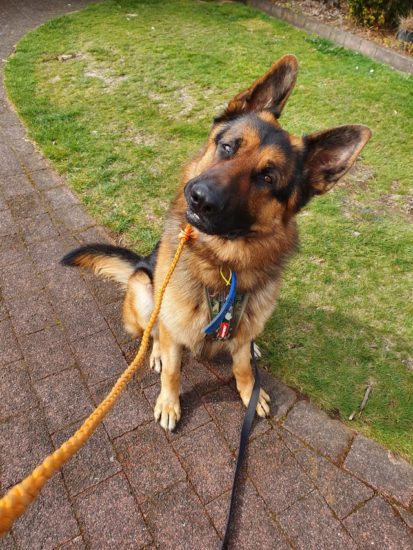
German Shepherds Crossed With Great Danes Are All-Around Good Family Pets
Are GSD Great Dane mixes good around children?
While German Shepherds may lack patience for children, especially strange ones, Great Danes typically are loving and playful around young people.
While you would need to socialize your Shepherd to accept a child as part of her flock, you must teach a Great Dane to be gentle and mindful of his size.
Great Shepherds may be unpredictable around children, but many of them display the easy affection of the Dane parent.
Again, you must exercise caution when you have such a large dog around toddlers or infants.
Commonly, Shepherd Dane mixes enjoy small kids but can act dangerously rambunctious. Great Shepherds typically have more energy than purebred Danes.
What can you expect around other dogs?
German Shepherds can get along with other dogs, typically with plenty of socialization at an early age.
It is not uncommon for Shepherds to prefer to be the only animal in a household, but some also learn to get along with cats.
The typical GSD has a high prey drive, one which early breeders refined for herding purposes.
It is Shepherd’s nature to chase fast-moving objects, which include small animals and children.
German Shepherds also have a very combative history with military training, Schutzhund guard requirements, and even some dog fighting.
If you go to a dog park, you will often see Great Danes dancing around the field, perfectly comfortable with canine playmates.
Despite their proficiency as ancient hunters, Great Danes seem to enjoy social interactions with both animals and people.
If your Shepherd Dane puppy inherits more of the Great Dane personality, she will be friendly and playful around other dogs. Those more like Shepherds will need heavy exposure to other dogs at an early age.
You should always supervise your Shepherd mix around small dogs because of her size.
It is not difficult for an oversized dog to seriously injure a toy breed even if the larger canid intends no harm. Moreover, minor arguments can quickly turn ugly between dogs with vast size differences.
The Great Dane German Shepherd Mix Is intelligent, But Not For Beginner Dog Owners
Not all mixed-breed puppies inherit the smarts of their parents, but Great Shepherds are intelligent like the GSD.
German Shepherds rank second or third in intelligence, combining working proficiency, obedience, and instincts.
However, German Shepherds are also a breed with a strong mind and a high incidence of overbearing dominance.
Stanley Coren ranked the Great Dane 88th, and thus average, among 138 dog breeds.
While the Dane does not excel in obedience or as a working breed, she shows a remarkable ability to figure things out on her own.
Great Danes also still possess good hunting skills.
Great Danes with Shepherd bloodlines are often cooperative and highly trainable with an outgoing temperament.
Some may inherit willfulness from the Great Dane. Qualities from both parents suggest the Great Shepherd needs persistence and consistency with her training as well as firmness and clear leadership.
How Much Exercise Will Your Dane Shepherd Require?
German Shepherds historically bred to sustain long periods of work through the day, need large amounts of activity.
If you own a Shepherd or ever did in the past, you know how intense and driven the breed, is and how high its energy levels are. German Shepherds regularly need up to two hours of exercise a day.
Great Danes require an hour of exercise every day, not having quite the stamina that a German Shepherd does.
Plan on providing 60 to 90 minutes of exercise for your Shepherd Dane mix every day, depending on her body structure, age, and energy levels.
Growing puppies need moderate exercise because their joints are susceptible to the damaging effects of overexertion.
Your puppy may potentially keep growing to 18 months old, so restrain your dog from jumping and excessive running until he has finished.
Consult with your veterinarian if you are unsure. A medical professional can tell you if your pup’s growth plates have closed.
You may also need to restrict exercise if your puppy or adult dog exhibits any signs of hip dysplasia.
- Appears to hop like a bunny as he runs
- Pain or obvious discomfort towards the rear end
- Difficulty getting up or laying down
- Can not or will not sit straight – always orients haunches to one side or the other
- Difficulty negotiating stairs
- Loss of muscle development in the hindquarters or exaggerated musculature of the forequarters
Are German Shepherd Great Dane Mixes Suitable For Apartment Living?
German Shepherds do not do well in small spaces. They are medium to large dogs with a limited ability to relax and stay still for extended periods.
Moreover, Shepherds can quickly become destructive when left alone. Finally, the GSD presents a new and expanding liability with leased properties and insurance agencies.
Most guard dogs feature on dangerous, banned, or uninsurable dog lists, and German Shepherds are not exempt.
Therefore, even if your German Shepherd liked living in a condominium, it is not likely that many property owners would allow it.
Great Danes may fit in with apartment living better than German Shepherds because they can lounge, but their size usually prohibits it.
They find it difficult to get comfortable if the space is too small, and their tails are deadly to anything not nailed down.
Moreover, insurance companies are not extremely fond of giant breed dogs any more than they are of guard dogs.
According to Showbiz Cheat-sheets, Great Danes head the list in front of Rottweilers for undesirable canines for insurance companies.
Your Shepherd Dane mix will most probably look like a Great Dane hybrid to most concerned parties.
Insurance companies and rental properties will likely give your dog a second glance because of her size.
Some policies have strict guidelines that treat mixes the same as dangerous and banned purebred parent breeds.
While neither the Great Dane nor the German Shepherd is dangerous with appropriate socialization and training, always check all relevant bans before you decide to move into a residence with your Great Shepherd.
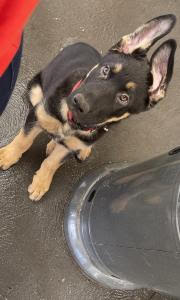
Great Shepherd Coat Type And Grooming Requirements
German Shepherds usually have a medium double coat, sometimes infamous for continuously shedding.
Such a coat ensures the GSD is well-insulated when it gets freezing and snowy outside and also in moderate heat.
Shepherds have two major sheds each year corresponding to seasonal changes that cause them to change out their undercoats. A Shepherd’s coat requires daily brushing but minimal shampooing.
Great Danes have a smooth and short coat generally without an undercoat, but they are still moderate shedders.
You should brush a Great Dane once or twice a week to remove dirt, stimulate circulation, and distribute oils to the fur.
Great Danes can struggle in cold weather because they have a thin coat and like other sighthounds, minimal body fat.
They do better in warm climates but do not have the insulating coats of German Shepherds. Their massive size can make it difficult for their bodies to lose heat.
Your German Shepherd Great Dane mix will most often inherit a short coat, but it may have an undercoat and probably will be denser than a purebred Dane’s.
You should brush your dog two or three times weekly to minimize shedding and keep her free of excess soil.
Bathing is only necessary twice a year, though most owners feel more comfortable with a monthly schedule. Use mild shampoos.
Check your dog’s ears regularly for dirt, an odor, discharge, or any signs of infection. Clip nails once every six to eight weeks.
Depending on their coats, Great Shepherds will probably tolerate the heat moderately well and perhaps also the cold.
Their size helps a little with frigid conditions, so most Shepherd Dane mixes do fairly well as long as temperatures do not dip too much below freezing and as long as they are not of a particularly lean body type.
Great Dane German Shepherd Mix Nutrition Requirements
Two major events affect how you feed your Great Shepherd. These crucial milestones are bloat and rapid growth.
The risk of gastric dilatation and volvulus (stomach distends and then flips) dictates that you should feed your Great Dane Shepherd mix a few small meals throughout the day rather than one or two large meals.
Feeding recommendations are about 5 to 10 cups daily for adult dogs, so spread that out over three feedings spaced apart by several hours.
Your Great Shepherd will be a large dog. Limiting nutritional intake helps slow your dog’s growth in an attempt to prevent conditions like joint dysplasia.
You also want to avoid an overweight puppy to decrease joint strain. You can formulate a homemade raw or cooked diet for your dog with your veterinarian or nutritionist.
There are also commercial diets that manufacturers specifically modify for large and giant breeds.
Summary
German Shepherd Great Dane mixes are large but lean dogs that are commonly black, black and white, or fawn.
These litter mates have a pretty standard look and notice their mother is a red and black sable working-type/pet quality GSD.
She may even have mixed heritage herself. There are two fawns and a black pup.
Occasionally, your Great Shepherd could be merle. This dog looks much like a Great Dane except for a heavier frame, more energy, and the semi-prick ears.
He has a single-minded focus common in German Shepherds.
Genetics are unpredictable, and your dog may sometimes have upright ears and look like a shepherd. Rarely you could see a black and tan Shepherd Dane mix.
Note the similarity of this dog to perhaps a Rottweiler Shepherd mix except for his striking ‘legginess’.
Recommended Reading:
- 15 Top Wanted German Shepherd Mixes: How to Know About
- 14 Differences Between German Shepherd Dogs and Great Danes






























